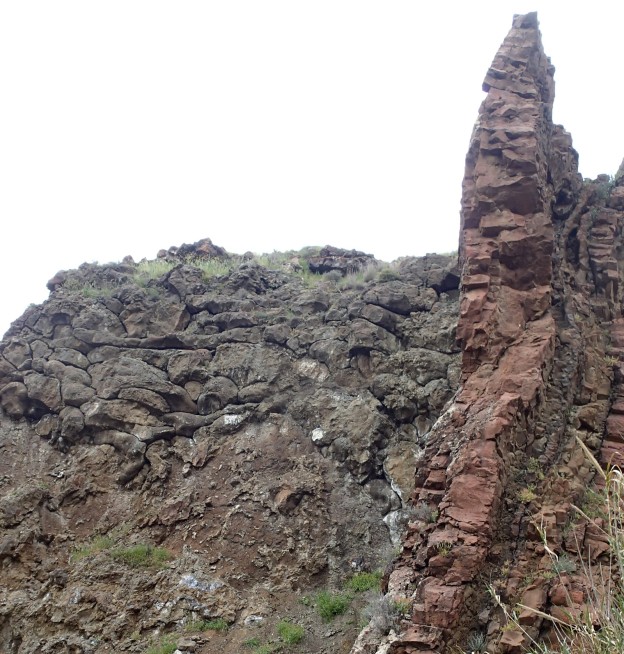The rest of our time in the Tróödhos mountains involved driving round the Geosites on other units of the ophiolite rocks; plenty of interesting geology for John and a huge range of plants for me, now that we were below the snow line.
The intrusive gabbros and other igneous rocks found at Geosites 34 and 31, just below the highest part of the mountains, allow rather more soil to develop than the mantle rocks at the top of the range and the increased diversity of vegetation reflects this.
Clockwise from top left: Minuartia picta, Smyrnium rotundifolium, Buglossoides incrassata, Erodium cicutarium subsp. cicutarium and Turritis laxa on igneous rocks near Fterikoudi
Barlia robertiana (left) and endemic Thymus integer (right) near Moni Panagias monastery, Lagoudera
Maybe my favourite growing on these rocks is the ridiculously coloured Vicia lunata!

At Geosite 3, on the very edge of the Tróödhos massif, sheeted dykes and pillow lavas exposed by the Maroullenas River provide a dramatic backdrop for a range of plants.

Pillow lavas on the left and sheeted dykes to the right
Clockwise from top left: Alyssum strigosum, Anchusa aegyptica, Sarcopoterium spinosum Torilis leptophylla and Phagnalon rupestre at Geosite 3
The limey soils forming on the chalks and limestones nearer the base of the mountains provide homes for a completely different group of calcicole plants, most spectacular amongst these the orchids, of many different species. Our attention was caught at Geosite 38, as we drove up towards the central Tróödhos, by large numbers of Orchis sezikiana on a damp patch of hillside above the road.
However a quick inspection showed that these were just the tip of the iceberg. Within a few minutes I’d found at least four different species (or sub species) of Ophrys.
Top: Ophrys subfusca subsp. cinereophila (left) and subsp. iricolor (right).
Bottom: Ophrys sphegodes subsp. mammosa (left) and Ophrys lutea subsp. galilaea (right)
Anchusa undulata ssp. hybrida is another lime-loving favourite which we found on the chalks at Geosites 20 and 21, south of Pera Pedi too, along with Fumaria, Reseda alba (mignonette), the bush-like Scabiosa cyprius and another Ophrys – Ophrys sphegodes subsp. alasiatica.

Chalk and flints at Geosite 21, near Ayia Mavri
Top, left to right: Anchusa undulata ssp. hybrida, Fumaria macrocarpa and F. officinalis.
Bottom, left to right: Reseda alba, Scabiosa cyprius Ophrys sphegodes subsp. alasiatica
The final reef limestone site we visited, Geosite 17 on the eastern edge of the massif, was another hotspot for both orchids and other calcicoles. A brief foray in the drizzle revealed a range of pinks, rock roses, knapweed, Ophrys, Onosma, from the primula family and an alien-looking Muscari amongst many others – definitely a site to go back to.
Top, left to right: Crupina crupinastrum, Helianthemum obtusifolium, Muscari comosum
Bottom, left to right: Onosma fruticosa, Silene aegyptica, S. colorata.






























